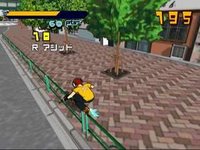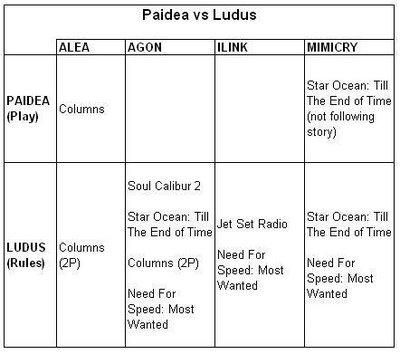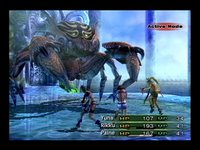Paidea and Ludus
In the ongoing debate about how we define videogames, there are several terms which I will explain and give examples for. The first two would each encompass a large number and variety of games and they are Paidea and Ludus.
Caillois (2001) discussed these terms in reference to the rules in place. If the rules are simple then the game is Paidea ('play') and if the rules are complex then the game is Ludus ('game').
Further discussion of these terms and the relationship between 'play' and 'game' caused others to add further definition to Caillois' explanation. Therefore Frasca modified Caillois' definition of Paidea and Ludus to;
- Paidea: “physical or mental activity which has no immediate useful objective, nor defined objective, and whose only reason to be is based in the pleasure experienced by the player”,
- Ludus: “activity organised under a system of rules that defines a victory or a defeat, a gain or a loss”,
(Frasca 1999)
Paidea and Ludus ExamplesPaidea:
Columns – a simple game where coloured columns of 3 gems fall down and need to be lined up to make them disappear. If the columns reach the top of the screen then the game ends (similar in concept to Tetris). There isn't a way to win this game as the game will just continue dropping more and more blocks, faster and faster. The emphasis is on the enjoyment of the player rather than them achieving a specific built in victory condition.
Ludus:
Soul Calibur 2 – A Beat-Em-Up game where the aim of the story

mode is to win eight fights which includes the 'boss' character Inferno (the baddie). The game also has a Weapon Master mode where the player plays through a huge number of fights with different victory conditions which will unlock items and further modes. Although this will give the player a multitude of rule set choices to play with, they are all strictly defined by the game itself and not the player.
Further Terminology: Alea, Agon, Ilink and MimicryThere were also four more terms Caillois (2001) proposed which games can be categorised into. These were Alea, Agon, Ilink, and Mimicry.
Alea:
Alea is Chance / Randomness. Columns in my example above could be described as a Alea game because the sequence of the coloured blocks is random. The player is unable to deduce a pattern and thereby 'predict' the next block and so can not plan too far ahead.
Agon:
Agon is Competition. Games which have an element of competition in them would be referred to as Agon such as Soul Calibur 2. Playing Soul Calibur 2, as a fighting game, could be said to be Agon in two ways. It has a two-player mode so the players could be in competition with each other but during one-player mode the player could be said to be in competition with the game itself.
Ilink:

Ilink is movement. These games have a large importance on how you move during the game. An example of this would be Jet Set Radio where you take the role of a Jet Powered Rollerblade wearing graffiti artist. In the game you are required to perform tricks and stunts which enable you to score more points, avoid obstacles and pursuers, and reach otherwise inaccessible areas / platforms.
Mimicry:
Mimicry are the simulation games. Not just the Command & Conquer and Transport Tycoon type simulations, but also games where there is a roleplay element. Therefore, Need For Speed: Most Wanted would fall into this category as you play the part of a street racer and you have to race in a semi-realistic way and play through many things which would really have to happen (car upgrades, learning the correct way to corner, how to get fast starts off the line, etc.).
CombinationsIn addition to all the above, there are some games (a lot some would say) which can fall into more than one category. Therefore depending on what the player is doing or decides to do the game could change category. One example is Columns which back at the start of this I put into Paidea. Some versions of Columns have a two player option where you have to survive for longer than your opponent. This then gives the game a victory condition element and could put it into Ludus. Games also combine across Alea, Agon, Ilink, and Mimicry. Need For Speed: Most Wanted can fall into the categories Mimicry, Agon and possibly Ilink. Then there is also the times where the game has specific goals or victory conditions but the player decides to ignore those and do there own thing. Star Ocean: Till The End Of Time is a roleplaying game where the player has goals which need to be achieved to progress the story. Achieving these goals will increase the characters stats preparing them for the final battle with the games boss. Before completing the current goal though a player could decide to go off and explore other areas, speak to every single NPC in the game so far or practice the minigames. These activities would remove the victory conditions because the player is no longer trying to achieve them and would make the game Paidea (at least for that play session).





